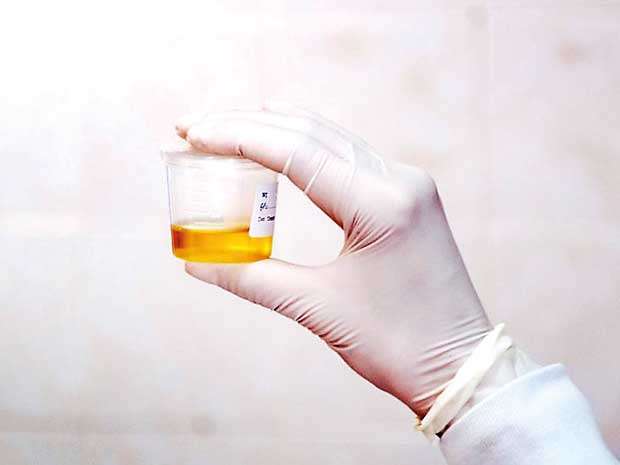Reply To:
Name - Reply Comment

 Urine is a liquid waste produce and excrete by our urinary system in order to remove waste products from our body. This process helps regulate the volume and composition of blood. Urine composition is mainly affected by 3 factors namely nutritional status, state of our metabolic process and ability of the kidney to selectively handle the material presented to it. Human urine consists primarily of water with various organic solutes including urea, creatinine, uric acid, trace amount of enzymes, hormones, pigments, mucins and inorganic ions such as sodium, potassium, chloride, magnesium, calcium, ammonium, sulfates and phosphates.
Urine is a liquid waste produce and excrete by our urinary system in order to remove waste products from our body. This process helps regulate the volume and composition of blood. Urine composition is mainly affected by 3 factors namely nutritional status, state of our metabolic process and ability of the kidney to selectively handle the material presented to it. Human urine consists primarily of water with various organic solutes including urea, creatinine, uric acid, trace amount of enzymes, hormones, pigments, mucins and inorganic ions such as sodium, potassium, chloride, magnesium, calcium, ammonium, sulfates and phosphates.
Urine analysis can provide useful information on various diseases and health conditions while it is a convenient and cost effective method. Urine analysis involves physical, chemical and microscopic examination and urine sediment. Normally clinical examination of urine is recommended by doctors for a number of reasons, including routine medical evaluations (screening of kidney disease, diabetes mellitus, liver disease, etc.), assessment of specific symptoms ( abdominal pain, painful urination, flank pain, blood in the urine or other urinary symptoms), diagnosis of medical conditions ( urinary tract infection, kidney stones, uncontrolled diabetes, kidney impairment, muscle breakdown, protein in urine, kidney inflammation) and monitoring of disease progression and response to therapy (diabetes related kidney disease, lupus related kidney disease, blood pressure related kidney disease, etc.).
Today Health Capsule discusses how we can make predictions about our health by studying the physical appearance of a urine sample. So we can get a general idea about our body condition and we can confirm it by doing a medical test to avoid delaying the identification of a disease and receive medical treatments for specific chronic diseases.
1. Colour and appearance
A healthy person’s urine is clear and pale yellow in color. The yellow color of urine is due to presence of yellow color pigments urochrome. Generally a high solute volume in urine increases the colour intensity of urine. A deviation from the normal colour of urine can be caused by certain drugs and vegetables such as carrot, beets, etc.
Normal urine is clear. The appearance of cloudy urine indicates a sign of possible abnormalities such as presence of pus cells or bacteria
Colourless: Happens due to drinking a high amount of water, diabetes mellitus, alcohol intake and intake of drugs which increase the production of urine (diuretics).
Milky: Sign of urinary tract infection by bacteria.
Orange color: Due to fever, excessive sweating, concentrated urea and presence of excess amount of urobilinogen in urine due to liver disease such as hepatitis or cirrhosis. Urobilinogen is formed by reduction of bilirubin in liver during break down of red cells. Normal urine contains some amount of urobilinogen. But due to unavailability or having a little amount of urobilinogen in urine than in normal range, it indicates improper liver function.
Red: Blood in urea due to infection, stones and tumors, excretion of free hemoglobin in urine due to hemolytic anemia or drugs such as Rifampicin or foods including beet root.
Dirty blue or green: When having cholera, drugs, genetic diseases such as familial hypercalcaemia.
Dark brown, brown red or yellow: Very concentrated urine due to lack of water consumption, increased urobilinogen in urine due to liver disease.
2. Turbidity and cloudiness
Normal urine is clear. The appearance of cloudy urine indicates a sign of possible abnormalities such as presence of pus cells, red
blood cells or bacteria.
Normally urine does not have a strong odor. Most of the time several medical conditions can cause strong or unusual urine smell including dehydration followed by ammonia smell urine...
But sometimes it may be due to precipitation of normal urinary constituents within the bladder as a result of changes occuring in urine pH. Normally alkaline (basic) urine may appear cloudy because due to the presence of phosphates and urates in urine. Occasionally, urine turbidity may result from urinary tract infection.
However, vaginal contamination in female patient often cause turbid urine.
3. Foamy urine: Most of the time having bubbly urine indicates there is lot of pressure behind the urine stream. But if urine is frequently ‘foamy’ it is providing signs of excess protein being excreted due to a dysfunctioning kidney.
4. Odor
Normally, urine does not have a strong odor. Most of the time several medical conditions can cause strong or unusual urine smell including dehydration followed by ammonia smell urine. Urinary tract infection by bacteria commonly cause urine to smell strong and diabetes is indicated by sweet smelling urine. Bad odor urine may also be produced by bladder fistula which occurs due to injury or bowel disease that allows the entry of intestinal bacteria into the bladder.
A strong urine odor can be another indication of liver diseases, and phenylketonuria like genetic diseases make mousey smell urine due to accumulation of amino acids called phenylalanine; because, this disease deducts the ability of breaking down phenylalanine. In conclusion, urine is a liquid waste product which screens vast range of health problems. This article helps to get a brief idea about your health at home by looking at appearance, odor and colour of your urine.
(The writer is a medical laboratory technologist at a private hospital and holds a MSc. Degree in Industrial and Environmental Chemistry from University of Kelaniya and BSc. Degree in Food Production and Technology Management from Wayamba University of Sri Lanka).